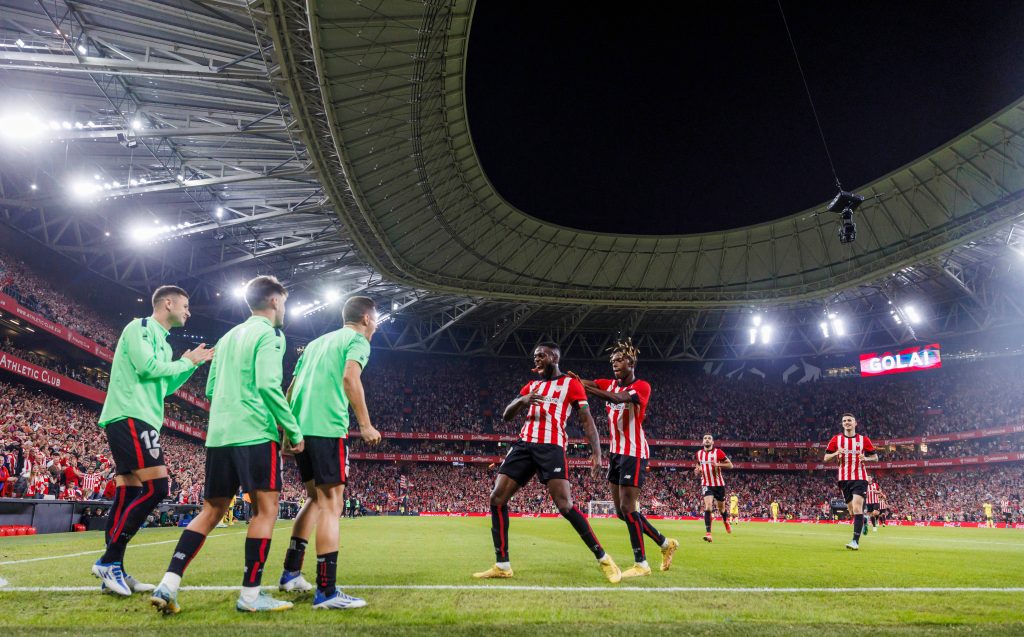Neel Shelat takes a look at another team exceeding expectations with an unusual tactical approach
They say ‘never go back,’ but Ernesto Valverde certainly does not follow that piece of advice. He moved to Bilbao for his fourth stint at Athletic Club at the start of this season, having made over 150 appearances for the side in his playing days, started his coaching career there in the early 2000s, and retaken charge from 2013 to 2017.
In both of his previous spells as the head coach of the first team, Valverde has led his side to continental football, and he appears to be on course to repeat the trick. At the time of writing, Athletic Club are in the European spots in La Liga and just three points away from third place. Based on xGD/90, they are the best of the rest in La Liga by some way behind Barcelona and Real Madrid.
It’s clear that Athletic Club and Ernesto Valverde are a match made in heaven, and neither seems to be able to thrive when they are apart. Since Valverde’s departure, Athletic failed to qualify for European football and were instead usually fighting to finish in the top half of the table. Valverde left, of course, because he was offered a job by Barcelona. Despite winning two LaLiga titles there, his Barca stint did not end well as his decision to favour pragmatism over club philosophy did not go down well with all the fans.
Funnily enough, it is this pragmatism that makes Valverde so successful at Athletic Club. In Bilbao, he has to work with limited resources as the club famously only field players from the Basque country, but luckily for them, their famously excellent youth academy has produced some serious talent. Within Valverde’s shrewd and flexible set-up, they have been thriving.
This set-up is quite intriguing because Athletic Club look to be quite a puzzling side based on the data. They have kept 52.8% of possession on average this season and have the third-highest field tilt in the league at over 60%, which points to them being a possession-dominant side that like to control matches. Yet, the passes per sequence and direct speed stats show them to be one of the more direct sides in the league.
(Image credit: The Analyst)
What is going on there? Let us investigate.
As ever, we will first turn to Valverde’s Coach ID Radar, which should ideally give us a basic overview of how his side plays against different levels of opposition.
Clearly, Athletic Bilbao generally tend to play in a more direct fashion against higher-quality opposition, and against sides they are expected to beat, they adopt a more possession-dominant approach.
Indeed, we see that Athletic Club’s approach to matches is quite malleable based on the sort of opposition they are facing in their possession stats too. In their 12 league games so far this season, their possession value has ranged from a high of 66% to a low of 35%. These are not one-offs either – they have kept more than 60% of the ball in four matches, and less than 40% in three.
The question then becomes: on what basis do these values fluctuate – just the quality of the opposition or something else?
The answer is quite straightforward: the style of play of the opponents. We can see a clear correlation between the possession kept by Athletic Club in a certain match and the average possession of their opponents over the course of the season.
Simply put, Athletic Club’s approach to a match is flexible. They like to keep possession and control the match when facing opponents that tend to defend more but are also happy to switch to a seemingly more defensive style of play against possession-dominant sides.
That is quite interesting in itself, but further, Athletic Club have used the same 4-2-3-1 formation in each of their 12 matches so far. What’s more, Valverde has tended to stick with the same personnel too: eight players have started 10 or more matches, while three others have started at least eight.
So, let us break down how Athletic Club are able to seamlessly switch between different approaches to matches even though they use the same formation and largely the same personnel.
Defending in a 4-4-2 block
Regardless of what sort of opposition they are facing, Athletic Club, like any other team, do have to defend at some points in every game. So, how they do that should be a good starting point for our analysis.
Out of possession, Athletic Club defend in a compact 4-4-2 block, with the wingers dropping back and the attacking midfielder pushing up alongside the striker.
The 4-4-2 structure is, of course, one of the most secure defensive shapes thanks to the horizontal coverage it provides across the midfield while also being centrally compact. Therefore, this shape enables Athletic Club to control even those matches where they do not dominate possession by restricting their opponents and keeping them at arm’s length. For example, in their most recent match against Villarreal, Athletic Club only kept 43% of the possession, but they had the greater field tilt at 63.8%.
Consequently, Athletic Bilbao are able to prevent their opponents from creating too many presentable chances. In fact, they have the lowest xG conceded tally in La Liga at 8.3, which is even lower than Barcelona, who have conceded just four league goals this season.
Clearly, Athletic’s defensive shape is crucial to their compactness and solidity, but it also has another purpose. While they do not look to press intensely high up the pitch, they do look to win the ball back in advanced areas. They do so by tempting the opposition to play the ball out wide and then closing down the player in possession against the touchline.
The data backs this observation up, as Athletic Club have a mid-table PPDA figure at 12.3, but have generated by far the greatest number of high turnovers in the league: 139 to be precise.
Attacking in Transition
Winning the ball high up the pitch is one thing, but it is of no good unless such turnovers lead to chances being created. Athletic Club are excellent in this regard too, as they have the most shot-ending high turnovers in the league (25), and the second-most goal-ending high turnovers (4).
Their success once again lies in their defensive shape, which acts as a springboard that makes them really dangerous in attacking transitions. Generally speaking, as soon as Athletic Bilbao turn over possession, the wingers dart down the channels, the striker runs in behind, while the attacking midfielder often looks for pockets of space between the lines to receive the ball.
What this means is that the player on the ball usually has a number of outlets to pass to with the wingers and striker running in behind, while these movements also ensure that there is a good number of bodies in the box when the ball reaches the final third.
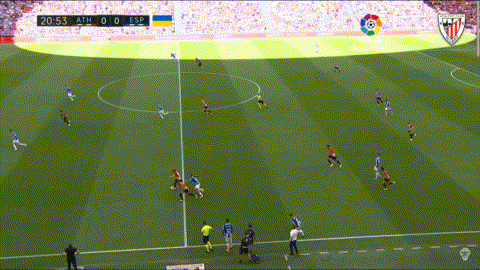
Of course, in most cases, not all attackers are involved on the ball in transition, but even in such situations, their movements help drag defenders away from their teammates and in turn contribute to the move that way. Notice, for instance, how Nico Williams (RW) forces the opposition left-back to move away from the ball in the below clip.
? @GorkaGuru9, goleador por partida doble.
— Athletic Club (@AthleticClub) August 30, 2022
1? ¡Zapatazo desde la frontal!
2? Precisión y colocación.
¡De todos los colores!#LaLigaHighlights #AthleticClub ? pic.twitter.com/CZxQ92tsDa
Structure with Sustained Possession
We have seen that Athletic Club are a very well-coached side out of possession and in transition, but often such sides leave a bit to be desired when they have sustained possession. That is absolutely not the case for Athletic, though, as Valverde has asked his side to implement a number of simple yet very effective principles.
Before we discuss those, let us first get an understanding of the structure they use in possession. Although their formation is seen as a 4-2-3-1 on paper, they act a lot more like a team that uses a 4-3-3 in possession, as the right-sided midfielder Oihan Sancet pushes forward, while Iker Muniain drops to the left from the attacking midfielder role.
The full-backs are encouraged to get forward, but they usually do so through late runs after the ball is close to the final third and not as regular overlappers. Instead, the wingers tend to stay high and wide. This is especially the case when the ball is one side of the pitch, so the near-side winger hugs the touchline, while the far-side winger shifts a little inwards.
These patterns are quite clearly reflected in the average on-ball positions of Athletic Club’s first-choice XI this season, which highlights the 4-3-3 sort of structure, and the dynamics on the wings.
Attacking with Sustained Possession
Within this framework, Athletic Club’s attacking play is centred around two primary patterns: creating and accessing space through movement, and wing play. The two are, of course, quite interlinked, but let us start by focusing on the first one.
While Athletic do have a pretty defined shape in possession, that only serves a basic structure for the players to work their magic in. The attackers in particular have a lot of freedom in terms of movement. For example, Iñaki Williams can often be seen drifting wide (especially to the right) or dropping deep, as his heatmap shows.

The wingers, while generally staying high and wide, can often be seen dropping deep or moving infield as previously discussed. The two attack-minded midfielders have the most positional freedom, as they are free to push forward, drop deep or even drift out wide. Muniain in particular can be seen popping up all over the place on the left side of the pitch.

All of these movements and fluidity among the players is what makes Athletic Club so fun to watch, and also so successful in being able to break down staunch opposition blocks. This is where the continuity of personnel proves greatly beneficial to Athletic. Since they have a clearly established starting XI comprised largely of players who have been at the club for a while, these eleven players have a very good understanding of each others’ movements and can work in tandem off the ball.
This is also where we see an element of directness in Athletic Bilbao’s attacking even in sustained possession. While they do keep a good deal of possession against defensive sides and patiently circulate it around the back, their progression to the final third is a pretty quick process that relies on fairly vertical passes.
Here is a great example of that, as Muniain makes a run towards the ball and drags an opponent with him to open up a passing lane. The left winger Álex Berenguer had initially come deep and pulled the full-back slightly out of position, so he then makes an out-to-in run in behind to get on the end of a pass played by a centre-back.

So, in a matter of seconds and just a couple of touches, Athletic go from having possession at the halfway line with 11 opponents behind the ball to getting in behind.
That was an example of Athletic Club accessing space through a couple of movements after starting from their basic 2-3-2-3 structure, but quite often, we see more complex moves where the majority of the side is involved in creating and accessing space in some way. Here is an example of that:
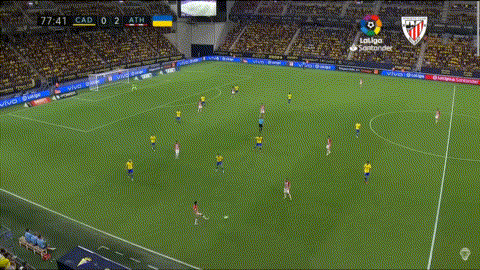
The move starts with Muniain receiving the ball from the left-back after drifting out wide, and he then finds Sancet in a pocket of space at the very heart of midfield, which was partly created by the 29-year-old dropping deep and wide. Sancet then turns and notices a large space on the right wing, which exists since Nico Williams has taken up a central position. Right-back Oscar De Marcos attacks this space and receives the ball, before crossing into a box where three teammates are waiting.
The second phase of that clip showed the role of movement in facilitating wing play, which is a key feature of Athletic Club’s attacks. If we take a look at their progressive passing map for the season, we find that the majority of such passes in the opposition half reach the wings.
Athletic’s structure in possession facilitates this wing play, primarily through the easy creation of triangles out wide involving a winger, full-back and midfielder. Of course, such triangles facilitate progression through passing, but the movements of players in such triangles can also create space for one another.
Here, for example, in a triangle formed on the left, the winger makes a run inside to open up space for the full-back, who receives a forward pass from the midfielder after moving into that space.
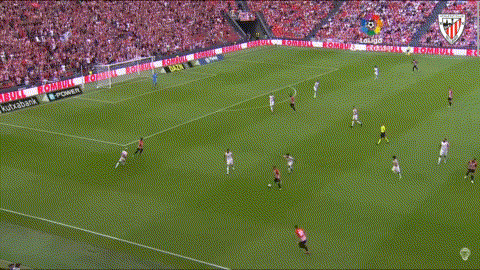
The previous clips that we saw were instances of opposition blocks being opened up from midfield, but as we have mentioned, Athletic do also take a pretty direct approach whenever possible. Often, the space they attack is in behind, usually created by the movement of the striker.
That striker is, more often than not, Iñaki Williams, whose key strengths include his off-ball movement and work rate. By dropping deep, he is able to open up space behind the opposition’s defensive line that his teammates, especially the wingers, can access. In the below instance, his brother Nico benefits by making an out-to-in run around his full-back to get in behind.

In other cases, Iñaki himself profits by first moving towards the ball, and then quickly changing direction to spin in behind.
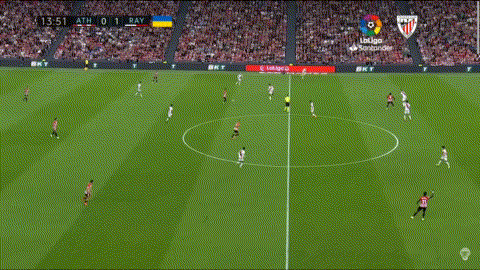
Key Players in Attack
We have already started to discuss some player-specific details about Athletic Club’s attacking play, but let us zoom in further and take a look at some specific personnel since Valverde has mostly used the same players in attack.
Let us start by continuing to focus on Iñaki Williams. His off-ball qualities have been apparent throughout his career, but he has often been called a striker who can do everything but score. This criticism is not entirely baseless either. Iñaki famously has a record of appearing in every league match in a streak that stretched back to 2016, but in the last three seasons, he has failed to hit double digits in terms of league goals. In fact, he has underperformed his xG tally in each of the last five seasons.
That is changing this year. Williams is still getting on the end of a number of good chances thanks to his movement, but what has changed now is that he has become much more clinical, as the previous clip showed. The Ghanian international already has five goals from 12 matches, and is just about outperforming his xG from open play.
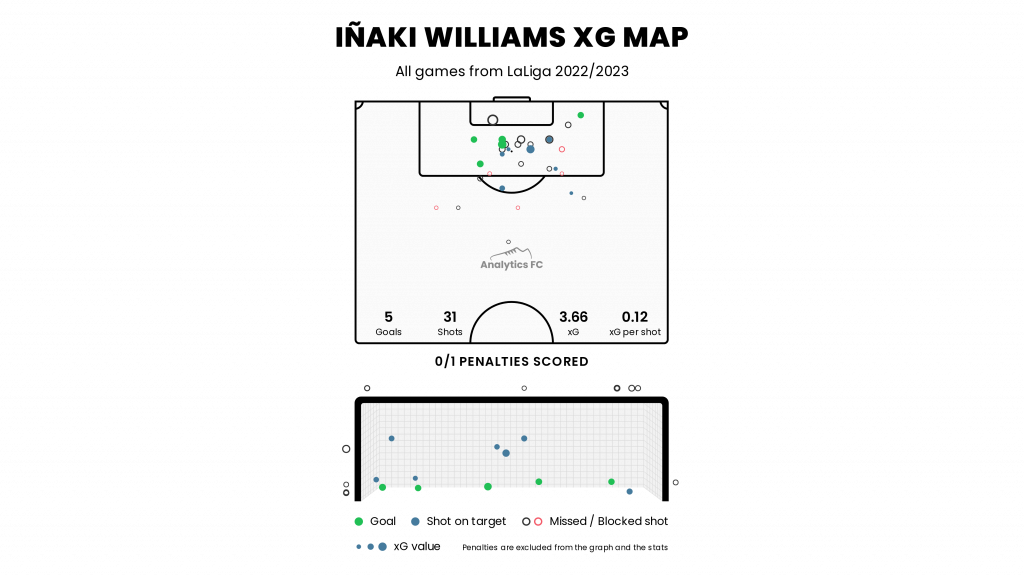
Iñaki has often benefitted from the chances created by his younger brother Nico, who has been the real breakout star of the season for Athletic Club. The 19-year-old winger has even earned a call-up to the senior Spanish squad on the back of his impressive performances. At the time of writing, he has three goals and as many assists in the league, but he brings much more to the team than that.
You might have noticed a right-side bias in Athletic Club’s progressive passes map that we saw previously. In fact, 41% of their touches in the attacking half have been taken on the right of the pitch. Clearly, Nico plays a large part in his side’s attacking play, and this is largely down to his dribbling qualities. He has attempted by far the most take-ons in his side (46), and his on-ball trickery has often proven key to unlocking resolute defences. So, he also plays a key role in getting his side forward through his ball carrying.
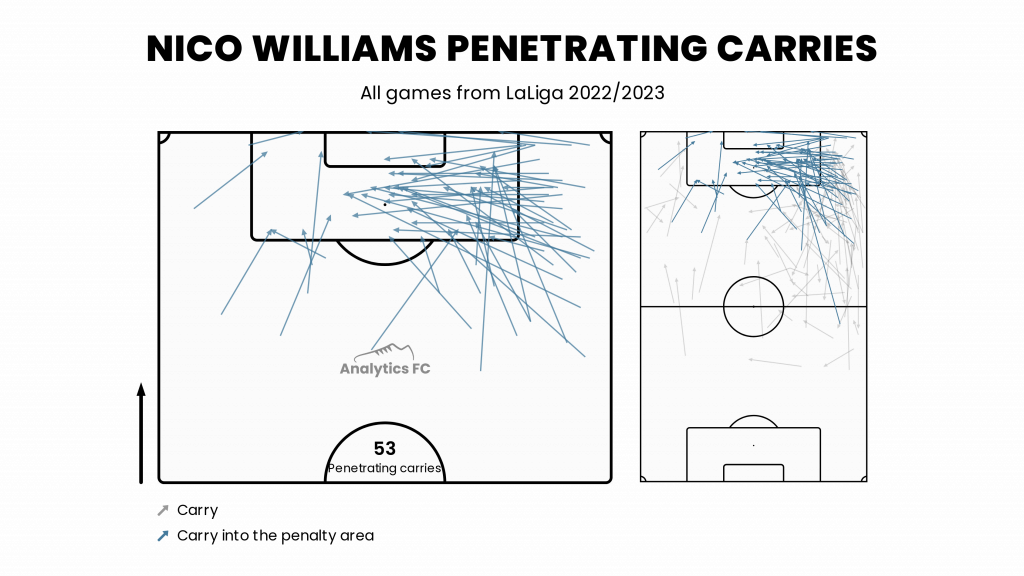
On the opposite flank, Berenguer has perhaps gone slightly underrated. In addition to three goals, he may just have one assist in the league this season, but he leads the way in his side’s xA charts.

Muniain places second in the squad in that metric, but it is tough to fully highlight his importance to the side through just event data. That is because one of his best qualities is his great understanding of the game and intelligent off-ball movement, which are crucial to the success of Athletic Club’s possession-play against low block sides as we have already discussed.
His attacking midfield compatriot Oihan Sancet has been a bit of a hipsters’ favourite this season. Having come through the academy as an attacker, the 21-year-old has starred in the hybrid right midfield role that we previously discussed this season. Like Muniain, his off-ball work has also been crucial to Athletic Club’s possession play. In addition to that, though, he has also made a habit of making late runs to the box to get on the end of cut-backs.

Discussion and Conclusion
Athletic Club have enjoyed a superb start to the season that has made them serious contenders for a European spot, and they could even have their sights set on the best of the rest spot behind Real Madrid and Barcelona as Atlético Madrid are enduring tough times. Valverde’s side’s great performances have been founded on a very interesting system, which seems to strike a great balance between continuity and pragmastism as well as control and directness.
While staying very consistent in terms of player selection and basic formation, Valverde has ensured that he is been very pragmatic both in his approach to matches against different types of opposition, and the tactical decisions behind his system, which serves to leverage the best of the players’ abilities.
Much like what we saw in our analysis of FC Lorient, Athletic Club are another side who do not fit any of the typical categories teams are often placed into. They are a team that tend to try and control games but do not necessarily rely on possession to do so, while adopting a fairly direct approach to deal damage in an attacking sense. They are testament to the fact that control and directness are not two binary opposites, but instead there exists a spectrum where both characteristics can be seen in some ways in the same side.
Stats courtesy Transfermarkt, Opta via Fbref and The Analyst, markstats.club and Vizz App.
Header image copyright: Imago/DAX Images

